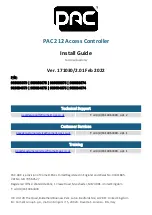
Glossary
A-18
Appendix 6
535-PROF User's Manual
control output:
The end product which
is at some desired value that is the
result of having been processed or
manipulated.
control mode, automatic:
A user
selected method of operation where
the controller determines the control
output.
control mode, manual:
A user
selected method of operation where
the operator determines the control
output.
control parameters:
User defined
values that specify how the process is
to be controlled.
controlled variable:
A process variable
which is to be controlled at some
desired value by means of
manipulating another process variable.
CRC (cyclic redundancy check):
An
error checking technique in which a
checking number is generated by
taking the remainder after dividing all
the bits in a block (in serial form) by a
predetermined binary number.
cycle time:
The time necessary to
complete a full ON-through-OFF period
in a time proportioning control system.
damping:
The decrease in amplitude
of
an oscillation due to the dissipation
of
energy.
damped, 1/4 amplitude:
The loss of
one-quarter of the amount of amplitude
with every oscillation.
dead band:
A temperature band
between heating and cooling functions;
the range through which an input can
be varied without initiating observable
change in output.
dead time:
The interval of time
between
initiation of an input change or
stimulus
and the start of the resulting
observable
response.
engineering unit:
Terms of data
measurement such as degrees
Celsius, pounds, grams, etc.
feedback:
Process signal used in
control as a measure of response to
control action; the part of a closed-loop
system which automatically brings
back information about the condition
under control.
FM:
Factory Mutual Research
Corporation; an organization which
sets safety standards.
gain:
The ratio of the change in output
to the change in input which caused it.
heat/cool control:
Control method
where the temperature of the end
product is maintained by controlling
two final elements using two of the 535
outputs.
hysteresis:
In ON/OFF control, the
temperature change necessary to
change the output from full ON to full
OFF.
hunting:
Oscillation or fluctuation of
process temperature between setpoint
and process variable.
icons:
Indicators on the face of the
controller.
input:
Process variable information
being supplied to the instrument.
integral:
Control action that
automatically eliminates offset, or
“droop”, between setpoint and actual
process temperature. Also “reset.”
internal voltage reference:
A
precision voltage source within the 535
controller, used to establish internal
calibration.
isolation:
Electrical separation of
sensor from high voltage circuitry.
Allows for application of grounded or
ungrounded sensing element.
JIS:
Japanese Industrial Standards.
Also Japanese Industrial Standards
Committee (JISC). Establishes
standards on equipment and
components.
default settings:
Parameters
selections that have been made at the
factory.
derivative:
Anticipatory action that
senses the rate of change of
temperature, and compensates to
minimize overshoot and undershoot.
Also “rate.”
derivative action:
(See control action,
derivative)
deviation:
The difference between the
value of the controlled variable and the
value at which it is being controlled.
digital input:
Used in this manual to
indicate the status of a dry contact; also
called “gate”.
DIN:
Deutsche Industrial Norms, a
German agency that sets standard for
engineering units and dimensions.
display, 1st:
The top, largest display of
controller face that is used to display
the process variable value.
display, 2nd:
The middle display of the
controller face used to indicate:
OPERATION Mode—- the setpoint,
deviation or output; in TUNING or SET
UP Mode — the parameter or
parameter menu.
display, 3rd:
The bottom display of the
controller face that is used to indicate:
Operation Mode — alarm or error
message; Tuning of Set up Mode —
the value or choice of the parameter.
disturbance:
An undesired change
that takes place in a process that tends
to affect adversely the value of a
controlled variable.
duty cycle:
Percentage of “load ON
time” relative to total cycle time.
dwell:
Also called "soak." The
designated period of time in which
the setpoint does not change after the
ramp has been completed.
earth ground:
A terminal used on the
535 to ensure, by means of a special
connection, the grounding (earthing) of
part of the controller.







































